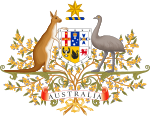
Back سياسة أستراليا Arabic Política d'Australia AST Avstraliyanın dövlət quruluşu Azerbaijani Палітыка Аўстраліі Byelorussian Държавно устройство на Австралия Bulgarian Politický systém Austrálie Czech Politics of Australia English Política de Australia Spanish سیاست در استرالیا Persian Australian politiikka Finnish
Politics of Australia | |
|---|---|
 | |
| Polity type | Federal parliamentary constitutional monarchy |
| Constitution | Constitution of Australia |
| Formation | 1 January 1901 |
| Legislative branch | |
| Name | Parliament |
| Type | Bicameral |
| Meeting place | Parliament House |
| Upper house | |
| Name | Senate |
| Presiding officer | Sue Lines, President |
| Lower house | |
| Name | House of Representatives |
| Presiding officer | Milton Dick, Speaker |
| Executive branch | |
| Head of State | |
| Title | Monarch represented by Governor-General |
| Currently | Charles III represented by David Hurley |
| Head of Government | |
| Title | Prime Minister |
| Currently | Anthony Albanese |
| Cabinet | |
| Name | Cabinet of the Federal Executive Council |
| Current cabinet | Albanese Ministry |
| Leader | Prime Minister |
| Deputy leader | Deputy Prime Minister |
| Ministries | 30 |
| Judicial branch | |
| Name | Judiciary |
| Courts | Courts of Australia |
| High Court | |
| This article is part of a series on the |
| Politics of Australia |
|---|
 |
| Constitution |
The Commonwealth of Australia is a federal parliamentary constitutional monarchy with a liberal democratic political system. The Constitution of Australia is the world's tenth-oldest, having been in place since Federation in 1901. Australia is a federation of the six states and the two territories.
Australia's system of government has been influenced by many other systems, mostly the British Westminster system and the American federalist system, so it has sometimes been described as the "Washminster system" (a blend of "Washington" and "Westminster").
There are three tiers of government in Australia: the federal government, the state/territory government and local government.
The Australian head of government is called the Prime Minister. The Australian head of state is the Monarch (King or Queen), who is also the head of state of the United Kingdom and many other countries (like Canada and New Zealand, as well as many others). The monarch is represented by the Governor General. The current Prime Minister is Anthony Albanese (who was elected in 2022) and the current Governor General is David Hurley, who represents King Charles III.